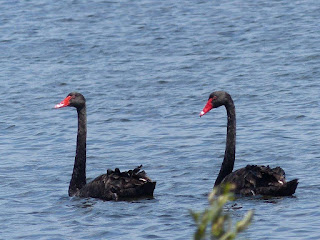Back to now ... today (24/8/20) ... it was a lovely clear day devoid of the strong (westerly & southerly) winds of the last couple of weeks. My mum had been taken up the coast by my sister for a treatment on her eyes and I thought this afternoon I would drop over and see if my dad wanted to head out for but of a bird watch. As I was heading off, my dear wife asked me to get some more timber for the fire from our supplier, and so off I set. I picked dad up & decided to pick the wood up on the way back ... fortuitous as it turned out ... either that, of dad is a talisman I need to take bird-watching much more 😉.
It was mid-afternoon and I wanted to see if I could see the white-bellied sea eagle glide past at Broadwater Beach lookout. Well, we had excellent fortune, even before we reached our objective, and then even more when we did get there!
Just before Broadwater bridge, approaching from the Bagotville direction I spotted a big bird up one of the riverside pine trees. I was almost past it and quickly braked causing dad some alarm about "why", turned around and here is what was there.
 |
| Osprey with a sizable mullet dinner |
Just around the bend and barely two riverside trees later was an even (literally) bigger surprise. Not with dinner, but certainly on the lookout and enjoying the rustle of the afternoon breeze.
 |
| White-bellied sea eagle on the riverside perch |
Just after this and as we were about to cross the bridge (and so no easy place to screech to a halt) a brahminy kite was circling and so in the space of about 300m we had seen the big three of the fishing birds of prey. Quite the start to my afternoon birdwatching whim.
 |
| White-bellied sea eagle in full glide |
AS I was taking some more snaps of the bird above as it circled and glided very near the lookout, dad caught my attention tapping the glass of the car window and pointing to the south. Another one had been circling even lower! Just as I was turning and re-focusing, the bird pulled it's wings back and dipped down behind the trees (dipped rather than dived or swooped as it might if it had been over water) and out of sight. Damn 😟 ... but go have a look because the dive had NOT taken it over the ocean at all. I peered through some of the heath bushes and could just make out the distinct white head in the distance. Alas, it was not possible to get a shot in frame given the thickness of the foliage. Fortunately, I wandered up the road a bit and was rewarded with a clearer view of this magnificent bird perched ever so proudly clutching a dead branch giving itself an uninterrupted 180 degree over the breaking surf - quite the kingdom. So, not just one white-bellied sea eagle today, but three!
 |
| White-bellied sea eagle surveying it's kingdom |



















































